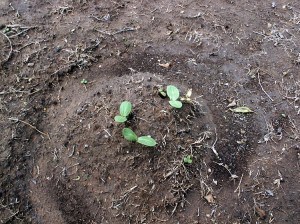It’s not to late to plant some edibles for this season! I always thought everything needed to go in by the end of May but there are many summer crops that you can start by seed now. Here are a few:
1. Watermelon– Melons like to have good drainage so make a mound about 1 foot wide with the dirt and plant 4 seeds spaced 1 inch apart and 1 inch deep in the top of the mound. Let nature take care of the rest! Try the Moon and Stars variety- we loved those!
2. Summer and Winter Squash– Follow the same instructions above for planting watermelon. This include yellow squash, patty pan squash, zucchini and many other types of squash. A few of these plants should yield more squash than you can handle. My landlord grows Lebanse squash and it is particularly yummy. Here is a recipe from her for a squash souffle that any vegetable hater would LOVE!
Squash Soufflé
2 pounds sliced squash
1 medium sliced onion
1 teaspoon salt
1 teaspoon sugar
3 tablespoons butter
3 tablespoons flour
1 cup milk
½ pound grated cheese
2 eggs
Combine squash, onion, salt and sugar in sauce pan and simmer with small amount of water until tender. Drain well. Mash with potato masher. Add eggs, melted butter, flour, milk and cheese (may be frozen at this point). Bake in buttered casserole dish for 30 minutes at 350°. Top with crumbs (Ritz or cheese cracker crumbs) and bake 10 minutes longer or until brown.
3. Dry Beans– Till up a weedy area in your garden, mound some dirt into a row and plant beans directly into the ground- I zigzag the seeds about 4-6 inches apart. The beans fix nitrogen out of the air and put it in the soil, compete with weeds and are nutritious to eat. I let the pods die and dry on the plant, hull them and store them for cooking in the winter. Some of my favorite varieties are coco black, Jacob’s cattle and hutterite.
4. Potatoes– I order our potato seed from Moose Tubers but they only accept orders for the spring potato season. I would recommend buying some potatoes from the farmers market and cutting them into 2-3 inch pieces and letting them dry. Put them in a dark cool place to encourage sprouting. When you see some growth starting you can plant them about 6 inches under ground. When the new growth emerges from the ground ‘hill’ the potatoes by mounding dirt around them. The potatoes are ready when the tops start to yellow and die back. Digging potatoes is really rewarding! We’ve grown and enjoyed purple haze and french fingerling.
If you would like to grow broccoli, cabbage, cauliflower, kale or collards it’s time to start seeds indoors now, for transplanting in August/July.



